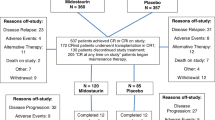Abstract
The addition of midostaurin, a FLT3-inhibitor, to intensive chemotherapy (IC) was previously shown to improve outcome of younger patients with FLT3-mutated AML. The toxicity and efficacy of adding midostaurin to IC in patients not originally included in the RATIFY study or with intensified daunorubicin dosing are unknown. We conducted a retrospective, multi-center, historical-control study to characterize the safety and efficacy of adding midostaurin to IC in a “real-world” setting. Sixty-nine adult patients were included in the analysis (midostaurin n = 34, historical controls n = 35) with a mean follow-up of 18.4 (± 15) months. Median age of patients was 60 (range 26–82) years; 32% and 20% of patients were > 65 and 70 years, respectively. No differences in baseline characteristics were noted between the groups. Midostaurin was administered with 90 mg/m2 daunorubicin in 29% of patients; One-third of patients experienced dose reductions/interruptions during midostaurin therapy. Overall toxicity was comparable between the midostaurin and control groups.CR/CRi rates were higher in patients treated with midostaurin compared with controls (80% vs. 57%, p = 0.047) and significantly more patients in the midostaurin group were transplanted in first remission (95% vs. 68%, p = 0.04).Median OS and DFS were higher in the midostaurin vs. control group (not reached vs. 11 months (p = 0.085) and 13 vs. 6 months (p = 0.09), respectively). In our analysis, midostaurin was not associated with increased toxicity including in older patients, in those with secondary AML or when administered with intensified daunorubicin dosage. Higher remission rates in the midostaurin group and increased transplantation rates in first CR were associated with a trend towards better outcomes.


Similar content being viewed by others
References
Dohner H, Estey E, Grimwade D, Amadori S, Appelbaum FR, Buchner T, Dombret H, Ebert BL, Fenaux P, Larson RA, Levine RL, Lo-Coco F, Naoe T, Niederwieser D, Ossenkoppele GJ, Sanz M, Sierra J, Tallman MS, Tien HF, Wei AH, Lowenberg B, Bloomfield CD (2017) Diagnosis and management of AML in adults: 2017 ELN recommendations from an international expert panel. Blood 129:424–447
Ley TJ, Miller C, Ding L, Raphael BJ, Mungall AJ, Robertson A, Hoadley K, Triche TJ Jr, Laird PW, Baty JD, Fulton LL, Fulton R, Heath SE, Kalicki-Veizer J, Kandoth C, Klco JM, Koboldt DC, Kanchi KL, Kulkarni S, Lamprecht TL, Larson DE, Lin L, Lu C, McLellan MD, McMichael JF, Payton J, Schmidt H, Spencer DH, Tomasson MH, Wallis JW, Wartman LD, Watson MA, Welch J, Wendl MC, Ally A, Balasundaram M, Birol I, Butterfield Y, Chiu R, Chu A, Chuah E, Chun HJ, Corbett R, Dhalla N, Guin R, He A, Hirst C, Hirst M, Holt RA, Jones S, Karsan A, Lee D, Li HI, Marra MA, Mayo M, Moore RA, Mungall K, Parker J, Pleasance E, Plettner P, Schein J, Stoll D, Swanson L, Tam A, Thiessen N, Varhol R, Wye N, Zhao Y, Gabriel S, Getz G, Sougnez C, Zou L, Leiserson MD, Vandin F, Wu HT, Applebaum F, Baylin SB, Akbani R, Broom BM, Chen K, Motter TC, Nguyen K, Weinstein JN, Zhang N, Ferguson ML, Adams C, Black A, Bowen J, Gastier-Foster J, Grossman T, Lichtenberg T, Wise L, Davidsen T, Demchok JA, Shaw KR, Sheth M, Sofia HJ, Yang L, Downing JR, Eley G (2013) Genomic and epigenomic landscapes of adult de novo acute myeloid leukemia. N Engl J Med 368:2059–2074
Schlenk RF, Dohner K, Krauter J, Frohling S, Corbacioglu A, Bullinger L, Habdank M, Spath D, Morgan M, Benner A, Schlegelberger B, Heil G, Ganser A, Dohner H (2008) Mutations and treatment outcome in cytogenetically normal acute myeloid leukemia. N Engl J Med 358:1909–1918
Garcia JS, Stone RM (2017) The development of FLT3 inhibitors in acute myeloid leukemia. Hematol Oncol Clin North Am 31:663–680
Stone RM, Mandrekar SJ, Sanford BL, Laumann K, Geyer S, Bloomfield CD, Thiede C, Prior TW, Dohner K, Marcucci G, Lo-Coco F, Klisovic RB, Wei A, Sierra J, Sanz MA, Brandwein JM, de Witte T, Niederwieser D, Appelbaum FR, Medeiros BC, Tallman MS, Krauter J, Schlenk RF, Ganser A, Serve H, Ehninger G, Amadori S, Larson RA, Dohner H (2017) Midostaurin plus chemotherapy for acute myeloid leukemia with a FLT3 mutation. N Engl J Med 377:454–464
Stone RM, Manley PW, Larson RA, Capdeville R (2018) Midostaurin: its odyssey from discovery to approval for treating acute myeloid leukemia and advanced systemic mastocytosis. Blood Adv 2(4):444–453
Common Terminology Criteria for Adverse Events (CTCAE) Version 4.0 Published: May 28, 2009 (v4.03: June 14, 2010)
Shimony S, Reiss Mintz H, Shvartser Beryozkin Y, Shoham A, Raanani P, Wolach O (2019) Necrotizing hemorrhagic gastritis following acute myeloid leukemia induction with midostaurin: an unexpected complication. Acta Haematol 10:1–4
Burnett AK, Russell NH, Hills RK, on behalf of the United Kingdom National Cancer Research Institute Acute Myeloid Leukemia Study Group (2016) Higher daunorubicin exposure benefits FLT3 mutated acute myeloid leukemia. Blood 128(3):449–452
Schlenk RF, Weber D, Fiedler W, Salih HR, Wulf G, Salwender H, Schroeder T, Kindler T, Lübbert M, Wolf D, Westermann J, Kraemer D, Götze KS, Horst HA, Krauter J, Girschikofsky M, Ringhoffer M, Südhoff T, Held G, Derigs HG, Schroers R, Greil R, Grießhammer M, Lange E, Burchardt A, Martens U, Hertenstein B, Marretta L, Heuser M, Thol F, Gaidzik VI, Herr W, Krzykalla J, Benner A, Döhner K, Ganser A, Paschka P, Döhner H (2019) Midostaurin added to chemotherapy and continued single-agent maintenance therapy in acute myeloid leukemia with FLT3-ITD. Blood 133(8):840–851
Author information
Authors and Affiliations
Corresponding author
Ethics declarations
Conflict of interest
OW, YO, and PR report past membership on an advisory board for Novartis, OW received speaker honoraria from Novartis.
Midostaurin was supplied by Novartis via an extended access program from April 2016 to January 2018.
Ethical approval
All procedures performed in studies involving human participants were in accordance with the ethical standards of the institutional and/or national research committee and with the 1964 Helsinki declaration and its later amendments or comparable ethical standards.
Additional information
Publisher’s note
Springer Nature remains neutral with regard to jurisdictional claims in published maps and institutional affiliations.
Rights and permissions
About this article
Cite this article
Berger, T., Rozovski, U., Moshe, Y. et al. Midostaurin in combination with intensive chemotherapy is safe and associated with improved remission rates and higher transplantation rates in first remission—a multi-center historical control study. Ann Hematol 98, 2711–2717 (2019). https://doi.org/10.1007/s00277-019-03795-8
Received:
Accepted:
Published:
Issue Date:
DOI: https://doi.org/10.1007/s00277-019-03795-8




